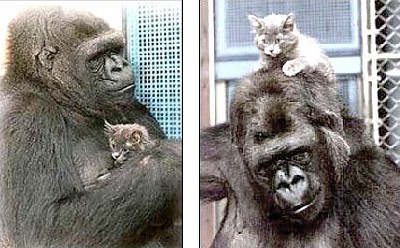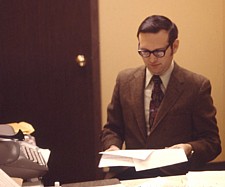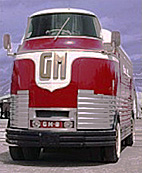APRIL
27, 2009 ![]() 1927
COLOR AND MORE
1927
COLOR AND MORE
I was only a small boy when my family went to the First Methodist Church one night to watch a silent movie. The year was about 1954. A portable screen had been set up next to the pulpit, and a plank had been placed across the backs of two pews to support a 16-millimeter projector.
The feature that night was the 1927 Cecil B. DeMille classic, The King of Kings. Scenes from the Gospels were reverently dramatized and narrated with title cards, many quoting a Biblical chapter and verse. For us in our small-town church, the movie was not only silent but in black and white.
|
However, I’ve recently learned that a small part of it was shot in color. Mary Magdalene’s first scene used the two-strip Technicolor process, which appears primitive to us today. I’ve added some color frames from this movie to my earlier page about alternative color techniques. Click here. And while I was at it, I’ve updated other articles by adding four TV images from my youth. |
One from 1954 went into this article about single-camera interviews.
Two from Damn Yankees have been added to this entry about low-budget studio backgrounds.
And one is in this note about a TV "camera" that I once built. Part of it apparently traveled to the moon!
APRIL
24, 2009 ![]() WHO’S
“HE”?
WHO’S
“HE”?
Sometimes, when listening to the radio, I’m not paying attention. Or maybe I’m tuning to a different station. At any rate, I often find myself listening to the middle of a story.
And so she stabbed him in the chest! Apparently it wasn’t a deep wound, and he’s expected to recover, but she certainly got his attention. I wonder how this is going to affect her movie career. She’s going to be in jail for some time. Of course, this is not the first time he’s driven a woman to violence. We all remember how his first wife threatened him with a gun a few years ago. I think his brother was involved in that somehow, wasn’t he?
After a few minutes of this, my question is, “Who are you talking about?!”
In written material, it may be acceptable to keep using pronouns without restating their antecedents. If the reader gets confused, he can go back a page or two to find out who “he” and “she” are. But on radio, the audience has no rewind button, and you have to assume that some listeners are joining the conversation at various points throughout. They can’t ask, “So what are we discussing here?” The broadcaster should repeat the names occasionally. Some classic examples:
Back in the 1960s on ABC Radio, it must have been network policy to write news stories with a certain redundancy. I remember hearing many stories that went something like this.
In Philadelphia, two women and a young girl died in a fast-moving row house fire that broke out just after midnight. The cause is under investigation. Captain John Ayers told reporters that those on the second floor “didn't have a chance” in that fire last night in Philadelphia.
Anyone joining the story in the middle and wondering “What fire? Was it around here?” would hear the key facts repeated at the end.
And when Hank Stram was the radio analyst on Monday Night Football, I’d often hear him reorient his listeners.
He’s always been a very productive running back. His statistics dropped off a bit last season when he missed the last five games with the knee injury, but he’s back on track this year, and he sure looked good on that play. Talking about Barry Sanders.
|
UPDATE: Here’s a real-life example. On the first edition of the podcast “Movie B.S. with Bayer and Snider” in April 2010, the guys discussed their dissatisfaction with a certain actor in Clash of the Titans. If you started paying attention at 10:45 into the conversation, here’s what you heard.
But what we don’t know, even after listening for more than two and a half minutes, is who “he” is. They never did mention the actor’s name again. I rewound the podcast and discovered they were talking about Sam Worthington. |
APRIL
18, 2009 ![]() GOTHAM
GOTHAM
APRIL
13, 2009 ![]() GOOD
FOR YOU, BAD FOR ME
GOOD
FOR YOU, BAD FOR ME
When the media characterize news as “good” or “bad,” they’re not always looking at the big picture.
For example, take the weather. A forecast of 89° and sunny is generally proclaimed as good news, but that’s too hot for my comfort. A forecast of a rainy day is generally bemoaned as bad news, but not by the farmers whose crops need the rain. Those same farmers rejoice if the price of wheat goes up, but their joy is not shared by those of us who buy bread.
For another example, take the population. Although the Pittsburgh region lost 2,967 residents over the last year, the local newspaper found a “silver lining” in the fact that the loss was only half as large as usual.
"It is good news that the population decline has slowed down," said county spokesman Kevin Evanto.
Chris Briem, a regional economist at the University of Pittsburgh ... said he would not be surprised if the population figures released a year from now look even better for the region.
Southwestern Pennsylvania Commission ... Executive Director James Hassinger expressed confidence that the regional population will bottom out by 2015 and slowly tick upward afterward.
A larger population may be good news for businesses and construction workers and politicians. But should the rest of us want to see more traffic jams, more pollution, more overcrowded schools, and all the other consequences of the fact that there are already too many of us?
APRIL
7, 2009 ![]() KITTEH
IZ MAKIN NU FRENDZ
KITTEH
IZ MAKIN NU FRENDZ
APRIL
1, 2009 ![]() THE
WAYBACK MACHINE
THE
WAYBACK MACHINE
Seven years ago, in an age when this website was updated only monthly, there was one month when the home page resembled the front page of a newspaper. It looked something like this.
|
|
a personal website
|
Mr. Thomas
Goes to Washington
|
(The
One In Pennsylvania, That Is)
FEBRUARY 11, 1974 — Tom Thomas has left his home in Ohio to become the program director at TV-3, part of Washington Channels. "I"m happy to find that my new employer is still enthusiastic about locally-originated television," Thomas said. "We'll be covering community events: sports, politics, religious and civic ceremonies. "And I hope before long to be moving into my first apartment in Washington." Sometimes called "Little Washington" to distinguish it from the nation's capital, the small city of Washington, Pennsylvania, is located about 30 miles south of Pittsburgh. |
|
Tightwad
Relents, Makes Site Ad-Free
MARCH 16, 2002 —
Obscure author T. Buckingham Thomas has agreed to upgrade his free site on the World Wide Web by paying actual money to Yahoo GeoCities.
"I needed to increase the megabytes of storage and to enable uploads using File Transfer Protocol," Thomas attempted to explain. "And one side benefit is that those advertisements are gone. You know, the ones that used to drop down from the upper right corner every time you opened a new article."
Thomas's monthly expenditure, which used to be zero, has reportedly increased to $4.95. He expressed hope that his readers, who will continue to view this site at no charge, will appreciate the improvement.
TBT
MARCH
27, 2009 ![]() TOO
SLOW, TOO FAST, TOO SLOW
TOO
SLOW, TOO FAST, TOO SLOW
For lunch, I often visit one of several “family” restaurants in the area. If possible, I avoid the crowds by timing my visit for the middle of the afternoon. I’m in no hurry. However, I do seem to be out of sync with restaurant rituals.
When I arrive and ask for a table for one, the hostess is flummoxed. There are many empty booths and tables available, but where can she put me? Sometimes she has to call in her co-workers for a consultation. They puzzle over the seating chart, trying to determine which section should be burdened with my presence. How many servers are still on duty? Whose turn is it next? Finally, a decision is reached, and a notation is made on the chart.
But the hostess still isn’t ready to seat me. First she has to pick up a menu from a stack on her podium. Then she grabs another menu or two for the monthly specials or beverages or desserts. Then she obtains a placemat. Then she picks up a knife, a fork, and a spoon, although not separately; fortunately, they have already been packaged with a napkin wrapped around them. If I were a few decades younger, she might also pick up a couple of crayons so I could color the placemat. Only after she’s collected all this gear is she ready to lead me to my table.
Wouldn’t it be more efficient if each menu had pockets in its cover, to accommodate the secondary menus and the placemat and maybe even the silverware? If the whole kit had already been assembled in advance, the hostess would only need to grab one object per guest, not half a dozen.
When we arrive at the table, I’m asked for my beverage order even before I have a chance to sit down. “Can I bring you some coffee, or maybe an iced tea?” Now this might be appreciated by the customer who desperately needs a cup of coffee right away. But I’m not in a hurry, and there might be some unusual beverage listed on one of those menus that I might like to try. It’s not as though I’m going to agonize over the choice of the best wine to complement my entrée, but I’d prefer not be rushed.
If I do make a quick decision about the beverage, the waitress brings it a minute later and asks if I’m ready to order. I’ve only begun to page through the menu, so I ask for extra time. Fine, she says, I’ll be back. In another couple of minutes I’ve made my selection.
But she doesn’t come back.
Another five minutes elapse. By then, I’ve forgotten what my selection was.
In summary, the restaurant staff is too slow in figuring out where to put me, too fast in asking for my order, and too slow in taking it. These inconveniences are intolerable!! Can’t something be done??
|
MARCH
22, 2009 Remember those cardboard 3D glasses with the different-colored lenses? This spring, they've got a new pair of hues: Amber and Blue. My article by that name explains what's going on. I also use the new method to show you a few stereoscopic pictures, photographed between 1862 and 1984. |
MARCH
21, 2009 ![]() MAGIC
93
MAGIC
93
As the National Hockey League regular season nears the finish line, I’m reminded of the conventional wisdom that a team has to earn about 92 to 94 points in order to make the playoffs. Is that number correct? It's time for a little research.
The NHL’s team scoring rules were last amended in 2005 with the introduction of the shootout to eliminate ties. The winning team earns two points in the standings; a team that loses in overtime or by shootout, one point.
At the end of the season, the top eight teams in the Eastern Conference and the top eight in the Western Conference qualify for the playoffs. So if P9 represents the number of points earned by the ninth-place team in your conference, your goal is to earn more than P9 points.
Since the rule change, six of these races have been completed: three regular seasons in each of the two conferences. The average P9 has been 91.3, distributed like this:
|
Season |
Conference |
P9 |
|||||||
|
- |
- |
- |
- |
- |
- |
- |
- |
- |
- |
|
2005-06 |
Eastern |
90 |
|||||||
|
2005-06 |
Western |
92 |
|||||||
|
2006-07 |
Eastern |
91 |
|||||||
|
2006-07 |
Western |
95 |
|||||||
|
2007-08 |
Eastern |
92 |
|||||||
|
2007-08 |
Western |
88 |
The conventional wisdom appears to be correct. In five conference races out of six, 93 points would have been enough to qualify for the playoffs.
MARCH
19, 2009 ![]() TIMELESS
TABLEWARE
TIMELESS
TABLEWARE
On March 12, 1974, as I was moving into my first apartment, my mother gave me a 20-piece set of Corelle dishes — porcelain-like but microwave-safe, made from laminated glass.

MARCH
13, 2009 ![]() AT
THE EPOCH, I WAS 22 YEARS OLD
AT
THE EPOCH, I WAS 22 YEARS OLD
The things I learn from being curious!
The paper edition of TV Guide has been downgraded to the point that it’s inadequate for planning my television viewing. For more than 50 years I'd relied on this reference, but reluctantly last year I had to turn to the magazine’s on-line listings. However, they still don't list all of my cable channels, and some of the channel numbers are wrong, so I recently switched to the more accurate Zap2it.
I noticed when I requested a Zap2it schedule grid starting at 7 pm tomorrow night, the Internet address shown on my web browser ended in “fromTimeInMillis=1237071600000.” When I requested a grid that started an hour later, the long number changed to 1237075200000.
Does “TimeInMillis” perhaps mean “time in milliseconds”? Simple subtraction shows the latter number to be 3600000 greater than the former. One hour does in fact equal 3,600,000 milliseconds (1000 milliseconds in a second, multiplied by 60 seconds in a minute, multiplied by 60 minutes in an hour). Aha, I thought, I’ve broken the code.
But time in milliseconds since when? What was the starting point, when TimeInMillis would have been zero? Perhaps the most recent New Year’s Day?
I divided TimeInMillis = 1237075200000 by 3600000 to obtain TimeInHours = 343632, then divided that by 24 to obtain TimeInDays = 14318. Fourteen thousand days is considerably more than a year. Dividing it by 365¼ gives us 39 years and 73 days, approximately. Subtracting that from the current date brings us back to January 1, 1970, which was apparently the arbitrary starting point for the Zap2it schedule makers.
Some further research reveals that it wasn’t their idea. Computer programmers of the 1970s chose midnight on January 1, 1970, as the basis for something called Unix time or POSIX time. They called that zero moment “the epoch” and counted upward from there by milliseconds. The resulting 13-digit numbers may look awkward, but the arithmetic is easier with them than with our usual non-decimal combination of years, days, hours, minutes, and seconds.
Four weeks ago tonight, according to Wikipedia, Unix time reached 1234567890000. Nerds did not let the occasion pass unnoticed. “Parties and other celebrations were held around the world, among various technical subcultures, to celebrate 1234567890 day.”
What time is it now? This web page will tell you.
MARCH
9, 2009 ![]() JUST
TELL HER IT'S THE SACRED SEAL
JUST
TELL HER IT'S THE SACRED SEAL
My new classmates and I wore freshman beanies when we walked across campus to serenade the women's dorms. I wrote about it the next morning, and my account made it onto this website, where an Alabama student found it nearly 44 years later. The rest of the story is in my new poetic article Sing, Sing a Song. Be sure to click on the link at the end.
MARCH
3, 2009 ![]() WHO
KNEW?
WHO
KNEW?
A professional hockey team gets better results without its star player! Good baseball pitchers still work as fast as they did 50 years ago! The data to back up these surprising conclusions are in a new article called Hypothesis Disproved.
|
MARCH
1, 2009 During the Eisenhower administration, this towering vehicle might have been the first to bring me a demonstration of stereophonic sound. But it was television that first brought me a demonstration of nuclear fission. My sketchy recollections are in a new article called Atomic Ping-Pong.
|













 Today,
35 years later, these plates and bowls and cups are still in
use. As you can see, they’re still in perfect
condition. None has broken, chipped, faded, or aged in any
way. They’re as good as new.
Today,
35 years later, these plates and bowls and cups are still in
use. As you can see, they’re still in perfect
condition. None has broken, chipped, faded, or aged in any
way. They’re as good as new.